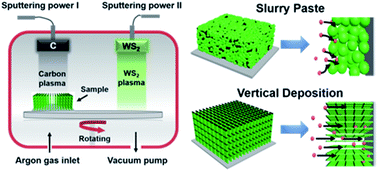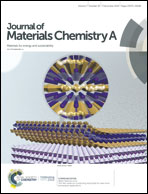Vertically constructed monolithic electrodes for sodium ion batteries: toward low tortuosity and high energy density†
Abstract
Nanomaterials for battery applications are strongly appealing to the industrial community, yet conventional electrode fabrication by employing a slurry paste restricts the potential performances of nanoengineered materials, particularly with commercial-level thickness and high mass loading. Here, physical vapor deposition (PVD) prepared monolithic electrodes composed of 40 μm-thick anisotropic WS2 vertical arrays on Al foil with a mass loading of 17.5 mg cm−2, and several sparsely inserted nanometre-thick carbon layers are reported. The monolithic anode shows an ultra-fast Na-ion diffusivity of 2.05 × 10−10 cm2 s−1, which is two orders of magnitude faster than that of the anode prepared from a slurry paste. As a sodium-ion battery (SIB) anode, the monolithic electrode achieves prominent areal and volumetric capacities of 5.57 mA h cm−2 and 1.39 A h cm−3, respectively, at a current density of 100 mA g−1 with less than 20% decay during 300 cycles. Furthermore, a SIB full cell composed of the monolithic anode and a Na2V3(PO4)3/C cathode can provide a reversible capacity around 125 mA h g−1 at 2C with an output voltage of 1.77 V, which demonstrates its potential for further development.



 Please wait while we load your content...
Please wait while we load your content...